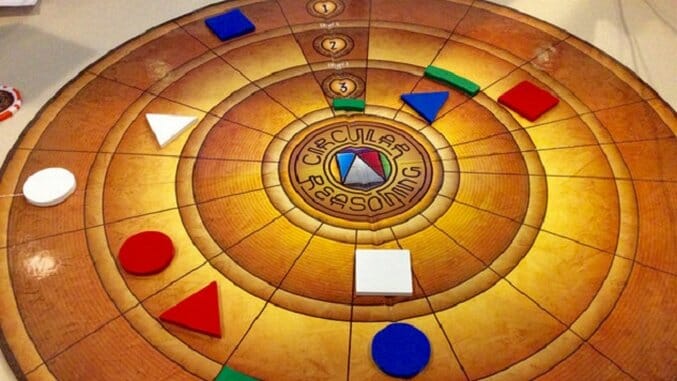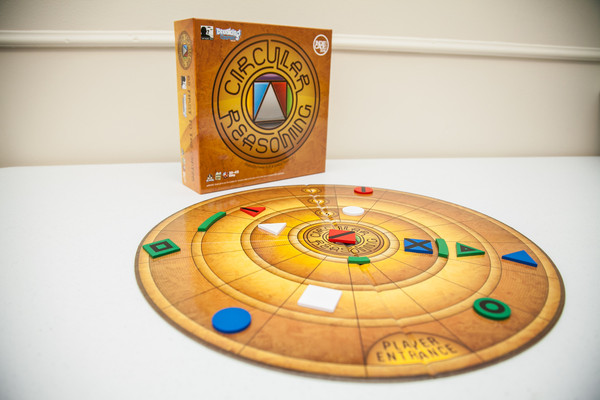
The rules for the abstract boardgame Circular Reasoning could fit on a 3×5 index card, and it might have fewer pieces than any game I currently own. The design of the board manages to give those very simple rules some modest strategy complexity, a game that seems to hit the family market target rather well without sacrificing adult playability.
Circular Reasoning’s board comprises three tracks and a center space, with gateway tracks separating each layer. Players must try to move their three pieces—a circle, a triangle and a square—on to the board, through each of the three gateways, and into the center before any other player does so. Each piece may move a specific number of spaces on a track; the circle moves two, the triangle three, and the square four, with movement in either direction allowed as long as a player doesn’t change direction mid-move. A piece may only move to an interior track by passing through the gateway piece that separates the two tracks (or the inner track from the center).
The gateways move clockwise each turn, however, advancing a number of spaces equal to the number of player tokens found on the track just outside of it. Any token can jump over other tokens except when passing through a gateway; if there’s a token just inside or just outside of the gateway, the gate is blocked until either the gate or the token moves. Tokens must move their assigned number of spaces, so players end up chasing the gateways around the board or turning around to try to catch it on the way back.

The real obstacle in the game, however, is the other players. There’s some light interaction because you can only move one token on each turn, so your decision each time around has to be built on what you might be able to do next turn, and what your opponents might be able to prevent you from doing. With just two players, this is much less of an issue—we rarely bumped into each other, and might have had one block total per game—but with four player, the game’s maximum, it’s inevitable, and often a player was forced to make a move s/he didn’t want to make because it was the only legal move available.
I played this many times with my daughter, age 9 and a real boardgame veteran; she thought it was boring after the first game and said she liked it after the third, so there you go. She had little trouble with the mechanics and just didn’t seem to get the idea that she couldn’t change direction after passing through a gateway, which is the only thing that isn’t perfectly clear from the rules (it’s explained late, more like a clarification than a core rule). The box is big but you could bring the entire game with you in a gallon zip-top bag, since the only pieces are the twelve tokens, the three gateways, and the poker chip for the start player in each round (it rotates clockwise). I don’t think this is a game for adult gamers, but with simple rules and maybe 20-25 minutes of play time, it’s a great simple one for the family on a weeknight.
Keith Law is a senior baseball writer for ESPN.com and an analyst on ESPN’s Baseball Tonight. You can read his baseball content at search.espn.go.com/keith-law and his personal blog the dish, covering games, literature, and more, at meadowparty.com/blog.